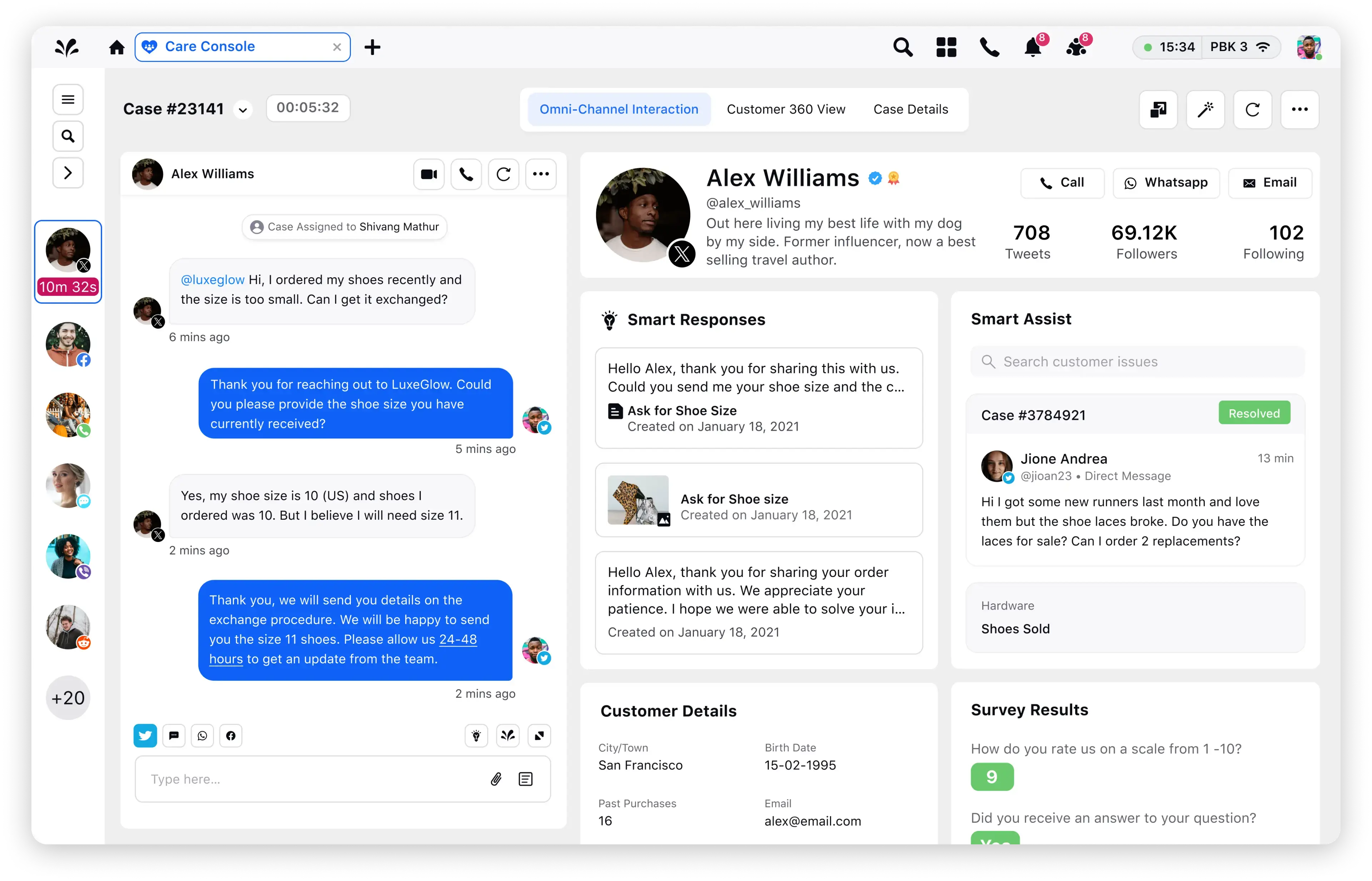The next generation of CCaaS is here
Digital-first customer service, enterprise-scale voice support. Redefine customer service with an AI-powered platform that unifies voice, digital and social channels. Power channel-less interactions and seamless resolution no matter the channel of contact.

Digital Experience Management (DXM): 5 Core Pillars and Best Practices
Most brand interactions today happen in the digital world. Whether searching for a company online, browsing its website, using its mobile app or engaging with its support channels —customers expect seamless, intuitive and engaging experiences at every touchpoint. That’s where digital experience management (DXM) comes in. It ensures that every digital interaction — from the first click to post-purchase support — is smooth, consistent and satisfying.
Yet even the most established brands can fail. Slow-loading websites, clunky mobile apps or disjointed support channels can quickly frustrate customers, leading to lost opportunities and eroded trust.
With 89% of businesses now competing primarily on customer experience, the pressure to get the digital experience right has never been greater.
This guide explores the key pillars of digital experience management, emerging trends, common pitfalls and actionable strategies to enhance your brand’s digital presence. We’ll also explore real-world case studies and expert-backed insights to help you turn your digital touchpoints into a true competitive advantage.
- What is digital experience management?
- 5 Pillars of digital experience management
- 4 Key trends in digital experience management
- Best practices for implementing DXM for organizations
- Challenges in digital experience management and how to overcome them
- How Standard Chartered implemented DXM
- Winning in the era of hyper-digital customer expectations
What is digital experience management?
Digital experience management (DXM) is the strategic process of overseeing, optimizing and unifying all customer interactions across a company’s digital platforms. It encompasses websites, mobile apps, social media, chatbots, self-service portals and other digital touchpoints, ensuring customers have a seamless and engaging experience at every step.
Despite living in a digital-first world, not all digital customer experiences are created equal. Customers interact with brands across multiple channels, devices and contexts — yet their experiences can feel inconsistent, frustrating or even broken. Here are some top reasons:
- Websites may load perfectly on one device but lag on another.
- Mobile apps might be intuitive for some users but cluttered for others.
- Chatbots and customer self-service options may fail to understand customer intent.
- Customer support may feel disconnected across different digital channels.
These inconsistencies impact customer satisfaction, loyalty and business growth. With 70% of customers expecting a seamless, personalized digital experience, brands can no longer afford to treat DXM as an afterthought.
Why is DXM critical for enterprises in 2025?
Even in a world where digital is the default, customer expectations constantly evolve. The rise of AI-driven personalization, real-time interactions and omnichannel customer engagement has raised the bar for brands. A well-executed digital experience management (DXM) strategy is necessary for enterprises to remain competitive. Here are the reasons:
- Ensure consistency—Customers interact with brands across multiple platforms. A disconnected experience leads to customer frustration. DXM ensures a seamless, unified experience across all digital touchpoints, reinforcing brand trust and credibility.
- Enhance engagement – Today’s customers expect real-time, interactive and hyper-personalized experiences. If a website loads slowly, an app has a confusing UI, or a chatbot fails to understand intent, customers disengage within seconds. DXM helps optimize digital customer journeys, keeping users engaged and satisfied.
- Boost loyalty – With rising competition, retaining customers is just as crucial as acquiring them. A frictionless digital experience reduces customer churn, encourages repeat interactions and fosters long-term customer relationships. Enterprises prioritizing DXM see higher customer retention and lifetime value (CLV).
- Drive competitive advantage – In 2025, simply having a digital presence won’t cut it— brands must differentiate through superior experiences. Businesses investing in AI-driven automation, predictive analytics and immersive digital experiences (like AR/VR-powered CX) will stay ahead of the curve, outperforming competitors with outdated digital strategies.
5 Pillars of digital experience management
The pillars we will discuss are the blueprint for staying on track. Miss one, and your DXM strategy risks crumbling. Nail them, and you’ll build experiences that stick.
Pillar 1: Omnichannel consistency
Today, customers interact with brands across multiple digital touchpoints including voice assistants. Imagine a customer shopping on your mobile app, adding items to their cart and later switching to the website — only to find an empty cart. This kind of disconnect creates frustration and drop-offs.
A unified digital presence with a consistent design, tone and navigation helps customers feel comfortable and familiar with your brand, no matter where they interact.
How omnichannel consistency works in the real world
Let’s take Delta Airlines as an example:
- A customer books a flight on Delta’s website.
- Later, they open the mobile app — and instantly see their booked flight, boarding pass and real-time notifications.
- They receive an automated WhatsApp message at the airport about a gate change.
- During the flight, they chat with a virtual assistant to reschedule their return date.
At no point does the customer need to re-enter their details or explain their request again. The experience is fluid, intuitive and hassle-free — exactly what DXM should deliver.
Pillar 2: Personalization at scale
Generic experiences frustrate customers. They want to feel seen, understood and valued. Personalization at scale answers the critical "Why should I care?" question by tailoring interactions to individual preferences — whether they're browsing an e-commerce store, streaming content or seeking customer support.
Also, customers can become overwhelmed by too many irrelevant choices. Personalization simplifies decision-making, guiding customers to what matters.
Take Spotify, which has redefined digital experience management through personalization:
"Daily Mix" playlists – AI analyzes listening habits to create tailored playlists that align with a user's taste.
AI DJ feature – This virtual DJ adjusts music in real-time based on mood, shifting from upbeat workout tunes to relaxing evening vibes.
Dynamic recommendations – The platform suggests concerts, new releases and podcasts based on user behavior.
🔖Related Read: Personalized Customer Experience: Top 4 Ideas + Examples
Pillar 3: Real-time customer interaction
In the digital world, speed is everything. Customers expect instant responses, especially during critical moments like checkout failures, service disruptions or urgent inquiries. A delayed response breaks trust, causes drop-offs and damages brand perception. Brands that master real-time customer interactions create frictionless experiences and prevent potential churn before it happens.
Why real-time interaction matters in DXM
✅ Boosts customer confidence – Instant support reassures customers that their issues are being addressed, strengthening loyalty.
✅ Reduces friction in digital transactions – Proactive interventions eliminate unnecessary steps and keep experiences smooth.
✅ Drives higher conversions— Engaging with customers at the moment ensures they complete desired actions — whether purchasing, signing up or troubleshooting.
Pillar 4: Automation and self-service
Modern customers expect instant, effortless resolutions — they don’t want to wait on hold for simple queries. AI-driven automation and self-service solutions make this possible by delivering quick, accurate, context-aware assistance across digital touchpoints.
They reduce operational costs, eliminate friction and empower customers to find answers and resolve issues on their own terms. However, you must ensure that customer-facing automation goes beyond rigid scripts — it should feel dynamic, human-like and intuitive.
Bridging the gap between automation and human-like experiences
The biggest challenge with automation is that many bots sound robotic, struggle with context switching and force customers to restart conversations if they change topics. This leads to frustration rather than convenience.
Sprinklr’s Conversational AI software addresses this head-on.
✅ Conversational AI that thinks like a human – Instead of following static decision trees, Sprinklr AI dynamically adapts to user behavior in real time.
✅ Context-aware interactions — If a customer pauses, switches topics or revisits a past issue, the AI remembers the conversation and resumes seamlessly — there is no need to start over.
✅ Generative AI for natural conversations – Powered by advanced language models, the chatbot engages in dynamic, human-like conversations that mimic real agent interactions.
For instance, imagine a customer initiating a chat about returning an order, then getting distracted and asking about a new product instead. Instead of losing track, Sprinklr’s AI seamlessly shifts context — helping the customer explore product details while keeping their return request open for later resolution.

Pillar 5: Security, privacy and compliance
Customers share personal data — from email addresses to payment details — with brands every day. However, data breaches, misuse of personal information and lack of transparency make them hesitant to fully engage. According to a McKinsey study, 87% of customers indicated they wouldn't engage with an organization if they had reservations about its security policies.
So, naturally, when customers feel their information is secure, their privacy is respected and the company is compliant with regulations, they are more likely to:
✅ Engage with digital touchpoints without hesitation.
✅ Share data for personalized experiences without feeling exploited.
✅ Remain loyal to the brand instead of switching to a competitor.
Apple exemplifies this commitment by weaving strong privacy practices into its ecosystem. It encrypts user data on devices and offers detailed information about how personal data is collected, stored and used.
Apple’s marketing also reinforces these values with campaigns like “Privacy. That’s iPhone,” highlighting how it stands against invasive tracking and upholds user consent. It also anonymizes browsing habits and limits app access to personal data. This ensures compliance with international data protection laws and signals to customers that the brand cares about their well-being, not just their wallets.

4 Key trends in digital experience management
With the pillars as your foundation, let’s explore the trends shaping how brands deliver standout digital experiences.
AI-powered hyper-personalization
In 2025, hyper-personalization goes beyond recommendations — it’s about anticipating customer needs in real-time. AI-driven recommendation engines now analyze real-time behaviors (e.g., abandoned carts, app scroll patterns, session duration) and adjust pricing, content, and product suggestions dynamically based on local weather, emerging trends, and even social sentiment. We all are familiar with the below, aren’t we? That’s AI-powered hyper-personalization at its best!
🛠️ How to thrive
- Leverage first-party data for deeper insights
With third-party cookies phasing out, you must prioritize first-party data collection (e.g., purchase history, app interactions, customer surveys). Use AI to identify behavioral patterns and create hyper-personalized recommendations without breaching privacy regulations.
- Deploy real-time adaptive content
Static recommendations are outdated. Invest in AI models that dynamically adjust content, offers and pricing based on real-time customer behavior. For example, if a user abandons a cart, trigger a personalized email or chatbot message with an exclusive incentive within minutes.
💡 Pro Tip: Test AI-driven recommendations across multiple customer touchpoints to ensure consistency and refine personalization strategies based on customer engagement metrics.
Real-time analytics & feedback loops
Real-time analytics helps you turn insights into immediate action. Similarly, feedback loops bridge the gap between what customers expect and what you deliver, enabling you to course-correct in real time. Whether identifying friction points in a checkout flow, responding to social sentiment spikes or dynamically adjusting content, acting in the moment makes all the difference.
Zara really knows how to use real-time analytics to keep up with what customers want. For example, when oversized blazers started trending on TikTok, Zara jumped on it fast. They used sales data to restock stores in just a few days instead of waiting weeks. This way, they kept shoppers happy, avoided empty shelves and made the most of the trend before it faded away.
🛠️ How to thrive
- Use AI-powered insights to detect customer pain points in real time.
AI-driven conversational analytics can identify sentiment shifts or service bottlenecks, allowing you to act before they escalate.
- Close the feedback loop quickly
If customers provide feedback, acknowledge and act on it swiftly—whether it's optimizing a checkout flow, tweaking an ad campaign or adjusting inventory.
- Combine real-time analytics with automation.
Automate responses where possible. For example, trigger a chatbot message when a user abandons checkout or adjust pricing dynamically based on demand surges.
🚀 Pro Tip: Set up real-time alerts for critical customer interactions — like a surge in negative social sentiment or an unexpected conversion drop — so teams can pivot instantly and protect brand reputation.

Voice & visual search optimization
Today’s consumers — especially Gen Z and Millennials — prioritize convenience over keystrokes. Many are skipping text-based searches entirely in favor of more intuitive discovery methods. Instead of typing long queries, users ask naturally (“Where’s the nearest vegan bakery?”) or snap a photo (like a jacket they love) to find the exact match online. For brands, it’s about meeting customers where their curiosity and impatience collide.
For example, Lowe’s has transformed home improvement shopping with AI-powered visual search. Their app allows users to upload a photo of a home project (e.g., a cracked tile or light fixture), and the system instantly identifies the exact product match or suggests close alternatives. This eliminates guesswork, speeds up decision-making and enhances the overall shopping experience.
🛠️ How to thrive Optimize product images with alt-text and schema markup for visual search crawlers. For voice, focus on natural language keywords (e.g., “best budget wireless headphones under $100”) and FAQ-style content. Tools with AI-driven image tagging can automate this without invasive data mining.
Proactive customer support
Today’s consumers expect brands to act before problems arise. Customers expect real-time alerts and instant solutions, whether a delayed flight or an out-of-stock item.
Brands that master proactive support reduce frustration, build trust and drive long-term loyalty. A simple example is notifying customers about an expiring credit card before a transaction fails, preventing unnecessary disruption.
The key to achieving this at scale is through AI-powered predictive analytics. By detecting friction points before they escalate, you can autonomously resolve issues, ensuring a smoother customer experience.
Delta Airlines has set the gold standard for proactive customer service by providing real-time updates on flight delays, gate changes, and baggage status — all before passengers even ask.
When a flight was delayed due to weather, Delta automatically rebooked affected passengers on the next available flight and sent updated boarding passes directly to their phones — before they even reached the airport — no scrambling, no stress — just a seamless experience.
Best practices for implementing DXM for organizations
Trends shift, but best practices ensure lasting success. Here’s how you can refine digital experience management strategies for long-term impact.
Establish a core performance metric
A well-defined performance metric aligns digital initiatives with your business goals. Without it, teams work in silos, leading to inconsistent strategies. You should identify a key metric, such as customer lifetime value or retention rate and use it to assess digital performance. Regular audits help track gaps between expectations and outcomes, ensuring continuous optimization.
Enhance cross-functional collaboration
Digital experience management fails when departments operate independently. You should establish cross-functional teams that integrate IT, marketing and customer experience departments. A shared analytics platform provides visibility, while performance-based incentives encourage team collaboration.
Prioritize user experience improvements
User experience must evolve with customer needs. Do not treat it as a one-time initiative; adopt it as a continuous process. Using post-interaction surveys is a great way to gauge users' feelings, and tools like heatmaps can help you spot any bumps in the road during their digital journey. Plus, A/B testing things like urgency messaging versus reassurance can really fine-tune your experience design.
Focus on metrics that drive business impact
Measuring digital success goes beyond surface-level indicators. Page views and click rates provide limited insight into customer engagement. Instead, you should track micro-conversions, such as newsletter signups or cart recoveries, to understand user intent. Mapping key customer journey stages from awareness to loyalty ensures alignment with revenue objectives. Competitive benchmarking against industry leaders, rather than past performance alone, prevents stagnation.
Challenges in digital experience management and how to overcome them
Even the best-laid DXM plans hit roadblocks. Here’s how to spot the potholes and pave right over them.
Data silos and integration issues
Data fragmentation across different departments — marketing, sales, support and product —creates a disjointed customer experience. Customers expect brands to remember their past interactions, but instead, they face repetitive conversations, inconsistent recommendations and misaligned communication across channels. Meanwhile, enterprises waste critical time reconciling spreadsheets rather than leveraging real-time insights.
How to overcome it
✅ Adopt a unified customer experience platform – Solutions like Sprinklr’s Unified-CXM break down data silos, ensuring a single source of truth for every customer interaction.
✅ Leverage AI-powered data unification – AI can automatically sync and deduplicate customer data across CRM, helpdesk and social channels, reducing inefficiencies.
✅ Enable real-time data sharing across teams – Implement API-driven integrations that allow seamless data flow between platforms.
Maintaining consistency in a fast-changing digital landscape
With new digital platforms constantly popping up, brands are always trying to keep up. This often leads to a mixed-up brand voice and inconsistent experiences for customers, plus it spreads marketing and support teams really thin.
How to overcome it
✅ Prioritize quality over presence – Brands should identify where their customers are most engaged instead of being everywhere at once and double down on high-impact platforms.
✅ Use AI for content adaptation – AI can automatically adjust messaging across different platforms while maintaining brand consistency.
✅ Centralize brand governance – Establish a content hub where all teams can access and follow brand guidelines.


Privacy and security concerns
Customers want hyper-personalization, yet they’re more conscious than ever about how brands collect and use their data. One data breach or privacy misstep can result in regulatory fines, PR disasters and lost consumer trust.
How to overcome it
✅ Adopt a privacy-by-design approach – Only collect essential customer data and be transparent about how it’s used.
✅ Leverage AI-powered fraud detection – AI can detect and prevent suspicious activities in real-time, minimizing breach risks.
✅ Build consumer trust with data controls – Give customers control over their data preferences, letting them customize privacy settings.
Scaling without sacrificing quality
Global expansion introduces logistical nightmares, from latency issues in digital experiences to payment failures in emerging markets. A seamless brand experience in New York can fall apart in Nairobi due to slow site speeds, language inconsistencies or a lack of localized payment options.
How to overcome it
✅ Optimize for local infrastructure – Invest in content delivery networks (CDNs) to ensure fast load times globally.
✅ Enable AI-driven localization – AI can dynamically translate and adapt content to regional preferences and cultural nuances.
✅ Offer region-specific payment and support options – Enable localized payment methods and provide multilingual customer support for seamless transactions.
How Standard Chartered implemented DXM
We learn best from real-world examples. Check out how Standard Chartered, a global finance leader, revamped its digital experience management.
How Standard Chartered optimized digital engagement
Standard Chartered, a multinational bank operating in 59 markets with 85,000 employees, faced challenges in providing seamless digital customer interactions. Customers engaged with the bank through various channels but often encountered fragmented experiences, requiring them to repeat information across platforms. This inefficiency added pressure on customer service teams and created a disconnected digital journey.
The bank needed a solution to unify customer interactions across multiple digital channels while reducing churn and improving service response times. They implemented Sprinklr’s Unified CXM platform, centralizing customer service, social listening and engagement into a single system. This integration allowed the bank to monitor platform conversations, analyze customer sentiments and respond with real-time insights. The impact was significant - customer social care interactions grew by 10% and first-response times improved to under 10 minutes.
Winning in the era of hyper-digital customer expectations
If you want to break down those silos, keep things consistent across all customer interactions, and use real-time insights for better service, you really need an AI-powered, all-in-one solution. That’s where Sprinklr’s Unified-CXM platform comes in.
Unlike the old-school CX tools that make you juggle many different systems, Sprinklr brings together sales, marketing, customer service, and analytics in one smart platform. Here’s what you get:
- Real-time analytics & feedback loops: Jump on customer insights right away to avoid frustrating situations before they even pop up.
- Omnichannel engagement: Create a smooth experience whether customers reach out via chat, social media, email, voice, or other means.
- AI-powered automation: Cut down on manual tasks and tackle customer issues proactively before they blow up.
- Enterprise-grade security & scalability: Keep everything compliant while still delivering a consistent experience worldwide.
Frequently Asked Questions
Yes. DXM (Digital Experience Management) focuses on optimizing all digital touchpoints. CX (Customer Experience) covers the entire customer journey, both online and offline. UX (User Experience) zeroes in on how users interact with a specific product or interface.
Accessibility ensures digital experiences are inclusive for all users, including those with disabilities. It’s not just compliance - it’s about expanding reach and building trust.
Track metrics like customer lifetime value (CLV), retention rates and conversion rates. Use tools that link DXM efforts to revenue, such as reduced churn or increased upsell opportunities.
No. DXM focuses on designing and delivering seamless digital experiences. Digital experience monitoring (DEM) tracks performance and identifies issues in real-time.
Absolutely. Consistent, personalized digital experiences build trust and emotional connections, turning one-time buyers into lifelong advocates.




